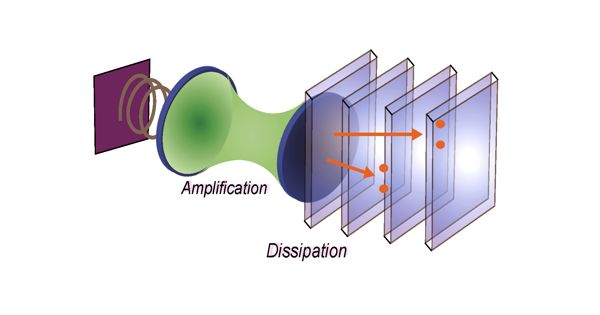The Casimir effect, a phenomenon emerging from quantum field theory, presents a fascinating interplay between the vacuum energy of space and the forces that arise from it. Imagine, for a moment, a world where tiny particles not only affect the surrounding vacuum but also engage with their environment in unexpected ways. What if we could say that the Casimir force has learned to swim? This proposition invites reflection on how quantum phenomena interact with fluid dynamics, challenging existing paradigms and prompting inquiries into the fundamental properties of the universe.
The Casimir effect manifests when two closely spaced, uncharged conductive plates induce a differential in energy states. Due to the zero-point energy of the vacuum, virtual particles pop in and out of existence, generating a net attractive force between the plates. However, in a fluid environment, the narrative becomes more intricate. The collision of virtual particles with fluid molecules introduces complexity, creating a hybrid framework of quantum mechanics and classical fluid dynamics.
To grasp the implications of the Casimir effect in a fluid medium, we must first delve into its underpinnings. In a vacuum, only limited modes of energy exist between the parallel plates, leading to the condensation of virtual particles, which induces the attractive Casimir force. Yet, when immersed in a fluid, the scenario morphs dramatically. The fluid molecules interact with the virtual photons, which modifies the effective vacuum state experienced by the plates. Consequently, does the Casimir effect still hold the same significance, or does it yield to the forces of viscosity and drag?
Examining the essence of the Casimir force in a fluid medium initiates a blend of theoretical inquiry and experimental challenges. One must ponder: how does the introduction of a fluid change the expected outcomes of quantum forces? A playful examination invites speculation—could the Casimir force somehow ‘learn’ to operate differently within the fluid, demonstrating adaptive characteristics not previously considered?
Researchers have sought to investigate how these nuances might unveil new aspects of quantum interactions. A salient point arises in the discussion of boundary conditions. In a fluid medium interacting with Casimir plates, changing the viscosity alters the effective boundary conditions for the quantum vacuum. This leads to variations in the attractive forces, potentially amplifying or diminishing the Casimir effect under certain conditions. It creates a dynamic playground for physicists to advance their understanding of the interplay between quantum forces and classical physics.
The interaction of quantum forces in fluids also risks sliding into the realm of turbulence. Turbulent flow could introduce transient fluctuations that obscure the more stable contributions of the Casimir force. Within this context, even the most minuscule adjustments in experimental conditions can lead to vastly different results, further complicating the picture. If the Casimir effect exhibits fluid-like characteristics, akin to ‘swimming’ through its environment, how does one effectively measure and reproduce these quantum manifestations?
Experimental methodologies must evolve alongside these theoretical advancements. The development of advanced metrology techniques, capable of discerning the subtle influences that fluids may impose on quantum forces, becomes paramount. Innovative approaches such as optomechanical systems could foster the necessary sensitivity, enabling precise measurements of Casimir-related phenomena in fluidic environments. The potential discovery of new effects arising from these interactions might broaden our comprehension of not merely quantum mechanics but also the nature of matter itself.
The broader implications of these considerations extend into various fields such as material science, nanotechnology, and even cosmology. If one contemplates the mechanisms at play, perhaps the interaction between Casimir forces and fluids may inspire novel materials that utilize quantum properties for enhanced functionality. Aspects such as drag reduction or energy manipulation become areas ripe for exploration.
To further contextualize the challenges posed, one could pose a critical question: How might these quantum influences in a fluid environment alter our perspective on the origins of the universe? Diseases such as cosmic inflation or the behavior of primordial particles could be scrutinized anew, as the dialogue between the quantum and the classical unfolds in realms previously unimagined.
The convergence of disciplines—quantum physics and fluid dynamics—acquires not only a mathematical framework but a philosophical one as well. Engaging with such questions compels the scientific community to reconsider established doctrines about forces, energies, and the very nature of reality. As physicists continue to explore this ‘swimming’ Casimir force, they are beckoned deeper into uncharted waters, where the quantum and classical collide.
Ultimately, the exploration of the Casimir force in a fluid environment serves as a metaphorical lens into the capabilities of the quantum world. It highlights the necessity to challenge existing paradigms and embrace innovation. In concluding, it sparkles with potential: the Casimir effect, in this liquid realm, poses not merely a curiosity of theoretical physics but a potential goldmine of discovery. Should physicists not just ask how the Casimir force swims but also how it might teach us new paths to understanding the cosmos?












